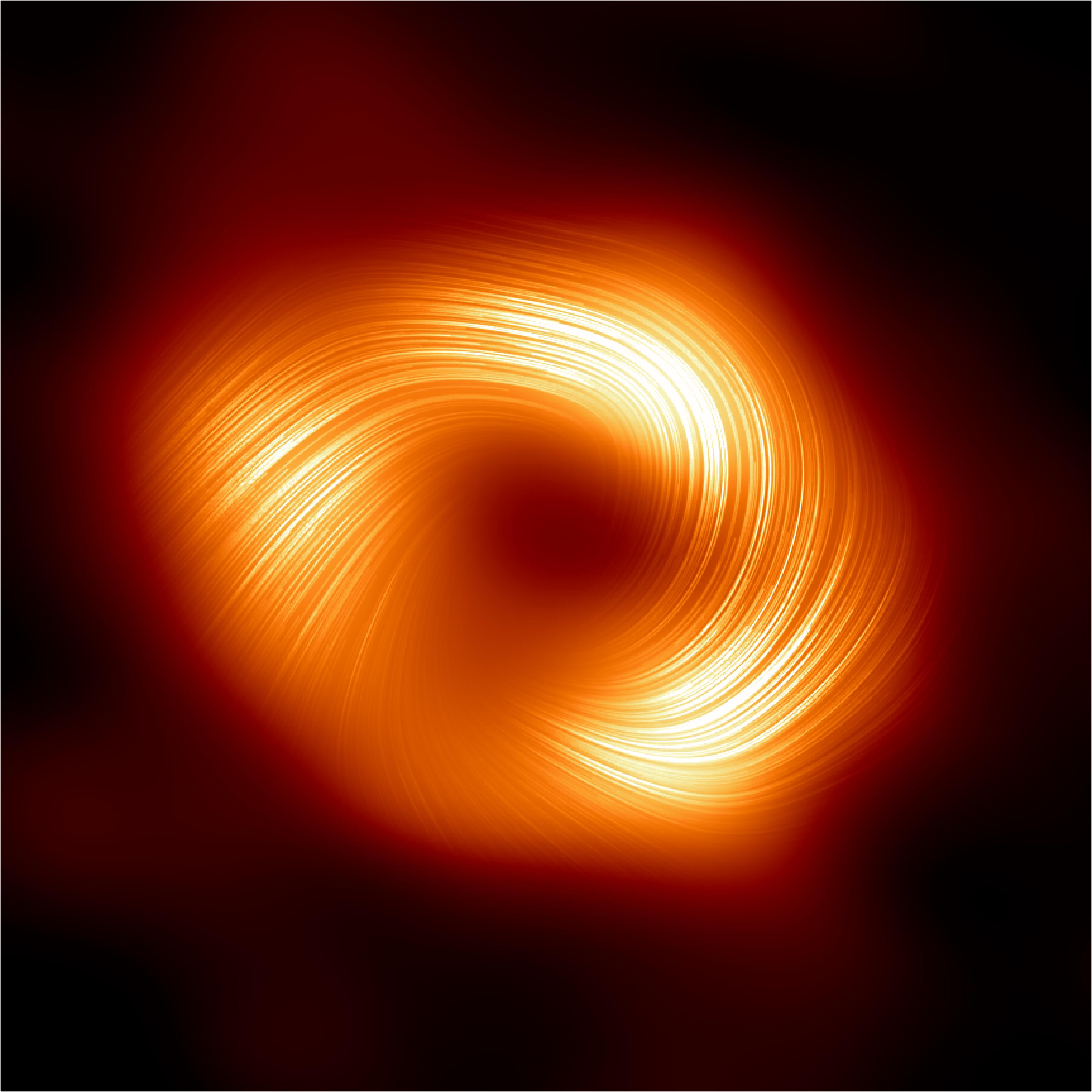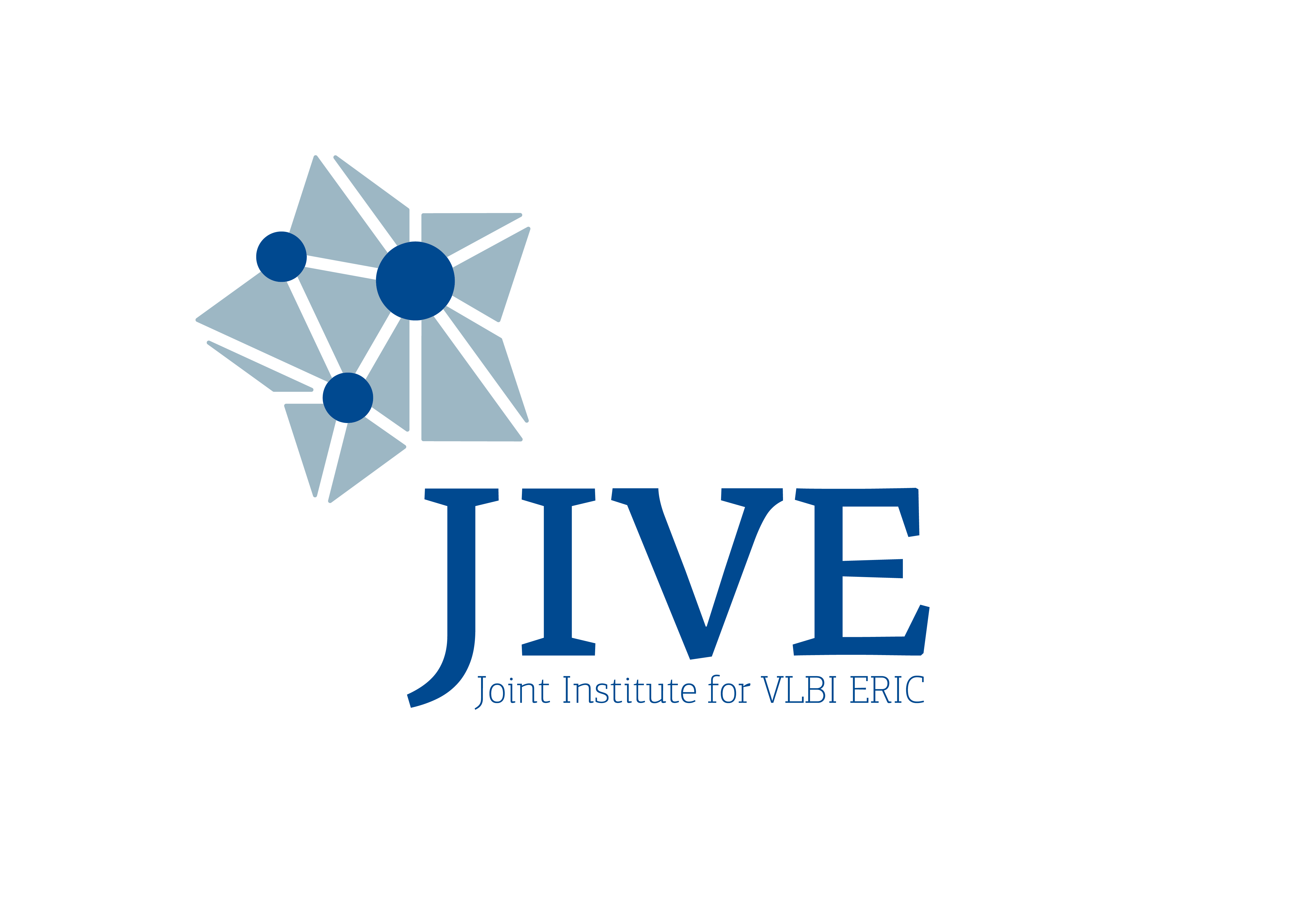
The Event Horizon Telescope (EHT) collaboration that produced the first ever image of our Milky Way black hole released in 2022, has captured a new view of the massive object at the center of our Galaxy: how it looks in polarised light. This is the first time astronomers have been able to measure polarisation, a signature of magnetic fields, this close to the edge of Sagittarius A*. This image shows the polarised view of the Milky Way black hole. The lines mark the orientation of polarisation, which is related to the magnetic field around the shadow of the black hole. Credit: EHT Collaboration.
Astronomers Unveil Strong Magnetic Fields Spiraling at the Edge of Milky Way’s Central Black Hole
A new image from the Event Horizon Telescope (EHT) collaboration, including scientists from JIVE, has uncovered strong and organised magnetic fields spiraling from the edge of the supermassive black hole Sagittarius A* (Sgr A*). Seen in polarised light for the first time, this new view of the monster lurking at the heart of the Milky Way Galaxy has revealed a magnetic field structure strikingly similar to that of the black hole at the centre of the M87 galaxy, suggesting that strong magnetic fields may be common to all black holes. This similarity also hints toward a hidden jet in Sgr A*. The results were published today in The Astrophysical Journal Letters.
Scientists unveiled the first image of Sgr A*—which is approximately 27,000 light-years away from Earth—in 2022, revealing that while the Milky Way’s supermassive black hole is more than a thousand times smaller and less massive than M87’s, it looks remarkably similar. This made scientists wonder whether the two shared common traits outside of their looks. To find out, the team decided to study Sgr A* in polarised light. Previous studies of light around M87* revealed that the magnetic fields around the black hole giant allowed it to launch powerful jets of material back into the surrounding environment. Building on this work, the new images have revealed that the same may be true for Sgr A*.
"What we’re seeing now is that there are strong, twisted, and organized magnetic fields near the black hole at the center of the Milky Way galaxy", said Sara Issaoun, NASA Hubble Fellowship Program Einstein Fellow at the Center for Astrophysics | Harvard & Smithsonian and co-lead of the project. "Along with Sgr A* having a strikingly similar polarization structure to that seen in the much larger and more powerful M87* black hole, we’ve learned that strong and ordered magnetic fields are critical to how black holes interact with the gas and matter around them".
Light is an oscillating, or moving, electromagnetic wave that allows us to see objects. Sometimes, light oscillates in a preferred orientation, and we call it "polarised". Although polarised light surrounds us, to human eyes it is indistinguishable from "normal" light. In the plasma around these black holes, particles whirling around magnetic field lines impart a polarisation pattern perpendicular to the field. This allows astronomers to see in increasingly vivid detail what’s happening in black hole regions and map their magnetic field lines.
"By imaging polarized light from hot glowing gas near black holes, we are directly inferring the structure and strength of the magnetic fields that thread the flow of gas and matter that the black hole feeds on and ejects", said Harvard Black Hole Initiative Fellow and project co-lead Angelo Ricarte. "Polarized light teaches us a lot more about astrophysics, the properties of the gas, and mechanisms that take place as a black hole feeds".
Scientists are excited to have images of both supermassive black holes in polarized light because these images, and the data that come with them, provide new ways to compare and contrast black holes of different sizes and masses. As technology improves, the images are likely to reveal even more secrets of black holes and their similarities or differences.
Mariafelicia De Laurentis, EHT Deputy Project Scientist and professor at the University of Naples Federico II, Italy, said: “The fact that the magnetic field structure of M87* is so similar to that of Sgr A* is significant because it suggests that the physical processes that govern how a black hole feeds and launches a jet might be universal among supermassive black holes, despite differences in mass, size, and surrounding environment. This result allows us to refine our theoretical models and simulations, improving our understanding of how matter is influenced near the event horizon of a black hole.”
The EHT has conducted several observations since 2017 and is scheduled to observe Sgr A* again in April 2024. Each year, the images improve as the EHT incorporates new telescopes, larger bandwidth, and new observing frequencies. Planned expansions for the next decade will enable high-fidelity movies of Sgr A*, may reveal a hidden jet, and could allow astronomers to observe similar polarization features in other black holes. Meanwhile, extending the EHT into space will provide sharper images of black holes than ever before.
More Information
This research was presented in two papers by the EHT collaboration published today in The Astrophysical Journal Letters: "First Sagittarius A* Event Horizon Telescope Results. VII. Polarization of the Ring" and "First Sagittarius A* Event Horizon Telescope Results. VIII. Physical Interpretation of the Polarized Ring".
Additional information on the EHT collaboration
The EHT collaboration involves more than 300 researchers from Africa, Asia, Europe, and North and South America. The international collaboration is working to capture the most detailed black hole images ever obtained by creating a virtual Earth-sized telescope. Supported by considerable international investment, the EHT links existing telescopes using novel systems — creating a fundamentally new instrument with the highest angular resolving power that has yet been achieved.
The individual telescopes involved in the EHT in April 2017, when the observations were conducted, were: the Atacama Large Millimeter/submillimeter Array (ALMA), the Atacama Pathfinder EXperiment (APEX), the Institut de Radioastronomie Millimetrique (IRAM) 30-meter Telescope, the James Clerk Maxwell Telescope (JCMT), the Large Millimeter Telescope Alfonso Serrano (LMT), the Submillimeter Array (SMA), the UArizona Submillimeter Telescope (SMT), the South Pole Telescope (SPT). Since then, the EHT has added the Greenland Telescope (GLT), the IRAM NOrthern Extended Millimeter Array (NOEMA) and the UArizona 12-meter Telescope on Kitt Peak to its network.
The EHT consortium consists of 13 stakeholder institutes: the Academia Sinica Institute of Astronomy and Astrophysics, the University of Arizona, the University of Chicago, the East Asian Observatory, Goethe-Universitaet Frankfurt, Institut de Radioastronomie Millimétrique, Large Millimeter Telescope, Max Planck Institute for Radio Astronomy, MIT Haystack Observatory, National Astronomical Observatory of Japan, Perimeter Institute for Theoretical Physics, Radboud University and the Smithsonian Astrophysical Observatory.
JIVE contact persons:
Ilse van Bemmel, Project Scientist. Email: bemmel@jive.eu
Mark Kettenis, Software Project Scientist. Email: kettenis@jive.eu
Huib Jan van Langevelde, EHT Project Director, JIVE Chief Scientist, Sterrewacht Leiden University, University of New Mexico. Email: langevelde@jive.eu
Junghwan Oh, Support Scientist. Email: oh@jive.eu
Des Small, Scientific Programmer. Email: small@jive.eu
Ioanna Kazakou, Communications Οfficer. Email: kazakou@jive.eu
Additional information on JIVE
The Joint Institute for VLBI ERIC (JIVE) has as its primary mission to operate and develop the European VLBI Network data processor, a powerful supercomputer that combines the signals from radio telescopes located across the planet. Founded in 1993, JIVE is since 2015 a European Research Infrastructure Consortium (ERIC) with seven member countries: France, Italy, Latvia, the Netherlands, United Kingdom, Spain and Sweden; additional support is received from partner institutes in China, Germany and South Africa. JIVE is hosted at the offices of the Netherlands Institute for Radio Astronomy (ASTRON) in the Netherlands.
The European VLBI Network (EVN) is an interferometric array of radio telescopes spread throughout Europe, Asia, South Africa and the Americas that conducts unique, high-resolution, radio astronomical observations of cosmic radio sources. Established in 1980, the EVN has grown into the most sensitive VLBI array in the world, including over 20 individual telescopes, among them some of the world's largest and most sensitive radio telescopes. The EVN is composed of 13 Full Member Institutes and 5 Associated Member Institutes.
